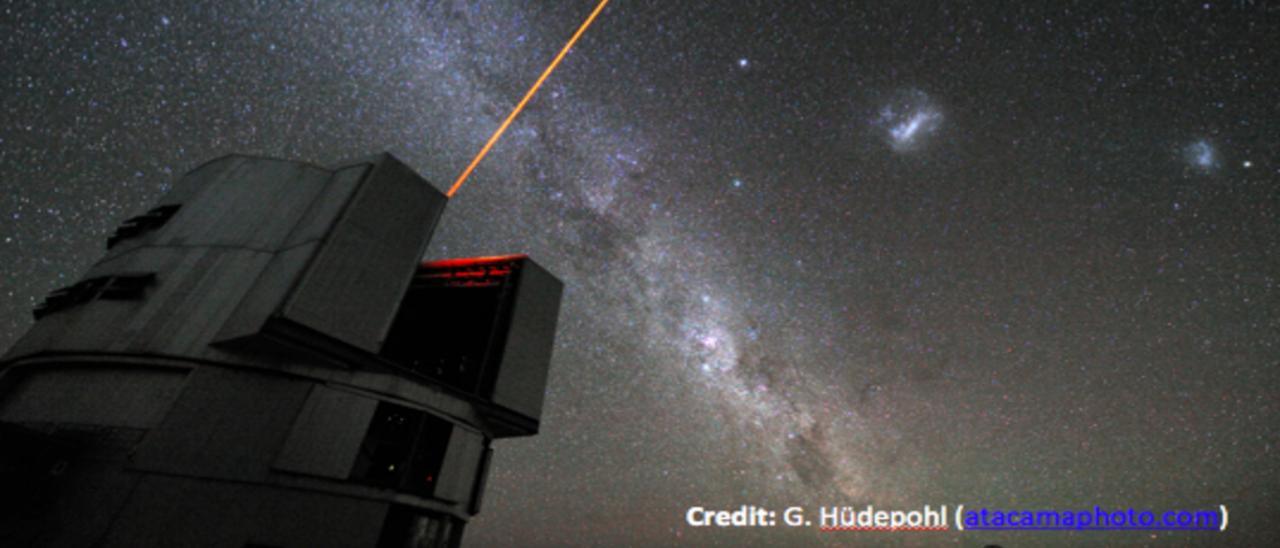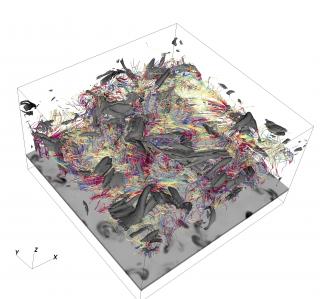Subvenciones relacionadas:
General
La formación y evolución de galaxias es un problema fundamental en Astrofísica. Su estudio requiere “viajar atrás en el tiempo”, para lo cual hay dos enfoques complementarios. El mas extendido consiste en analizar las propiedades de las galaxias a diferentes distancias cosmológicas. Nuestro equipo se concentra en el otro enfoque, denominado “Arqueología Galáctica”. Se basa en la determinación de las propiedades de las galaxias a partir del estudio de sus estrellas individuales. Según su masa, las estrellas pueden vivir tanto como el propio Universo, y por tanto nos permiten estudiar, con un detalle exquisito, como han evolucionado las galaxias desde su formación hasta el momento actual. Esta disciplina es el principal motor de grandes proyectos, tanto observacionales (como Gaia, SDSS, WHT/WEAVE, LSST, VISTA/4MOST, DESI o E-ELT/HARMONI) como teóricos (como las simulaciones cosmológicas Nihao, Magic y Auriga), en muchos de los cuales los miembros de nuestro equipo están involucrados. Esto asegura que la Arqueología Galáctica va a estar en un primer plano de la investigación astrofísica por mucho tiempo.
Nuestro objetivo es estudiar la formación y evolución de galaxias a partir de los ejemplos locales que pueden ser resueltos en estrellas y que, por lo tanto, pueden ser estudiados en un detalle imposible para galaxias mas distantes. En particular, el Grupo Local y su entorno inmediato contiene unas 80 galaxias de diferentes tipos morfológicos. Entre ellas, las más grandes son galaxias espirales (la Vía Láctea, M31 y M33), una docena de ellas son de tipo irregular (LMC), o irregulares enanas, y el resto son esferoidales. Así, podemos estudiar galaxias de diferentes tipos morfológicos en un gran rango de masas, desde espirales hasta las galaxias más pequeñas, que están incluso haciendo cuestionar el concepto de 'galaxia'.
Para este fin, usamos los telescopios actuales y un conjunto de técnicas complementarias: I) utilizando fotometría que llegue al turn-off viejo de la secuencia principal en el diagrama color-magnitud, es posible derivar su historia de formación estelar y caracterizar su evolución a lo largo de toda su vida; ii) la espectroscopia de estrellas individuales añade información directa sobre la cinemática y las abundancias químicas de las diferentes poblaciones estelares; iii) para los objetos mas cercanos, la astrometría precisa proporciona información sobre la distancia (y por lo tanto el brillo absoluto), el movimiento orbital, e incluso información 6-D completa; iv) las estrellas variables como RR Lyrae y Cefeidas aportan restricciones independientes sobre las edades y metalicidades de las poblaciones a las que pertenecen. Estas observaciones proporcionan información muy valiosa con la que contrastar las predicciones de los modelos cosmológicos de formación y evolución de galaxias, que consideran la influencia de un amplio abanico de procesos físicos.
Miembros
Resultados
Siguen una selección de resultados del Grupo de Investigación para el periodo 2020-2021. Para una descripción más completa, invitamos a visitar la página web del grupo.
1. Usando datos HST de la galaxia ultra débil Eridanus II se ha determinado (Gallart+2021) que su único evento de formación estelar hace 13 Ga fue muy corto (100-500 Ma). La energía liberada por las SN asociadas pudo ser suficiente para expulsar el gas. Esto pone en duda que reionización sea la causa de la finalización de la formación estelar, como se suele suponer.
2. Los varios episodios de formación estelar, extendidos hasta hace pocos cientos de millones de años, que hemos datado con precisión en las galaxias esferoidales Fornax (Rusakov+2021) y Leo I (Ruiz-Lara+2021) han permitido estudiar los efectos de las interacciones y las fusiones en la historia de la formación estelar de las galaxias enanas.
3. Al realizar por primera vez un modelo dinámico conjunto de la cinemática interna estelar y del gas HI de una galaxia enana del Grupo Local, WLM, pudimos determinar que su halo de materia oscura probablemente tenga un core y una forma 'prolate'; la co-existencia de estas características podría plantear un problema para self-interacting dark matter (Leung+2021).
4. Por primera vez usando simulaciones cosmológicas, demostramos que las fusiones de galaxias son una explicación viable para la presencia de rotación alrededor del eje major en el componente estelar de las galaxias también en la escala de las galaxias enanas (Cardona-Barrero+ 2021)
5. Se realizó la simulación cosmológica de la Vía Láctea con mayor resolución hasta la fecha (Grand+2021)
Actividad científica
Publicaciones relacionadas
-
A very dark stellar system lost in Virgo: kinematics and metallicity of SECCO 1 with MUSE
We present the results of VLT-MUSE (Very Large Telescope-Multi Unit Spectroscopic Explorer) integral field spectroscopy of SECCO 1, a faint, star-forming stellar system recently discovered as the stellar counterpart of an ultracompact high-velocity cloud (HVC 274.68+74.0), very likely residing within a substructure of the Virgo cluster of galaxies
Beccari, G. et al.Fecha de publicación:
22017 -
APOGEE chemical abundances of globular cluster giants in the inner Galaxy
We report chemical abundances obtained by Sloan Digital Sky Survey (SDSS)-III/Apache Point Observatory Galactic Evolution Experiment for giant stars in five globular clusters located within 2.2 kpc of the Galactic Centre. We detect the presence of multiple stellar populations in four of those clusters (NGC 6553, NGC 6528, Terzan 5 and Palomar 6)
Schiavon, R. P. et al.Fecha de publicación:
42017 -
The episodic star formation history of the Carina dwarf spheroidal galaxy
We present deep photometry of the Carina dwarf spheroidal galaxy in the B and V filters from CTIO/MOSAIC out to and beyond the tidal radius of rell ≈ 0.48 degrees. The accurately calibrated photometry is combined with spectroscopic metallicity distributions of red giant branch (RGB) stars to determine the detailed star formation and chemical
de Boer, T. J. L. et al.Fecha de publicación:
122014 -
Clear Evidence for the Presence of Second-generation Asymptotic Giant Branch Stars in Metal-poor Galactic Globular Clusters
Galactic globular clusters (GCs) are known to host multiple stellar populations: a first generation (FG) with a chemical pattern typical of halo field stars and a second generation (SG) enriched in Na and Al and depleted in O and Mg. Both stellar generations are found at different evolutionary stages (e.g., the main-sequence turnoff, the subgiant
García-Hernández, D. A. et al.Fecha de publicación:
122015 -
The Carina Project IX: On Hydrogen and Helium Burning Variables
We present new multiband (UBVI) time-series data of helium burning variables in the Carina dwarf spheroidal galaxy. The current sample includes 92 RR Lyrae—six of them are new identifications—and 20 Anomalous Cepheids, one of which is new identification. The analysis of the Bailey diagram shows that the luminosity amplitude of the first overtone
Coppola, G. et al.Fecha de publicación:
112015 -
Recovering star formation histories: Integrated-light analyses vs. stellar colour-magnitude diagrams
Context. Accurate star formation histories (SFHs) of galaxies are fundamental for understanding the build-up of their stellar content. However, the most accurate SFHs - those obtained from colour-magnitude diagrams (CMDs) of resolved stars reaching the oldest main-sequence turnoffs (oMSTO) - are presently limited to a few systems in the Local Group
Ruiz-Lara, T. et al.Fecha de publicación:
112015 -
The early days of the Sculptor dwarf spheroidal galaxy
We present the high-resolution spectroscopic study of five -3.9 ≤ [Fe/H] ≤ -2.5 stars in the Local Group dwarf spheroidal, Sculptor, thereby doubling the number of stars with comparable observations in this metallicity range. We carry out a detailed analysis of the chemical abundances of α, iron peak, and light and heavy elements, and draw
Jablonka, P. et al.Fecha de publicación:
112015 -
The Absolute Age of the Globular Cluster M15 Using Near-infrared Adaptive Optics Images from PISCES/LBT.
We present deep near-infrared J, {K}{{s}} photometry of the old, metal-poor Galactic globular cluster M15 obtained with images collected with the LUCI1 and PISCES cameras available at the Large Binocular Telescope (LBT). We show how the use of First Light Adaptive Optics (FLAO) system coupled with the PISCES camera allows us to improve the limiting
Monelli, M. et al.Fecha de publicación:
102015 -
Variable stars in Local Group Galaxies - I. Tracing the early chemical enrichment and radial gradients in the Sculptor dSph with RR Lyrae stars
We identified and characterized the largest (536) RR Lyrae (RRL) sample in a Milky Way dSph satellite (Sculptor) based on optical photometry data collected over ˜24 years. The RRLs display a spread in V-magnitude (˜0.35 mag) which appears larger than photometric errors and the horizontal branch (HB) luminosity evolution of a mono-metallic
Martínez-Vázquez, C. E. et al.Fecha de publicación:
122015 -
The effect of tides on the Fornax dwarf spheroidal galaxy
Estimates of the mass distribution and dark-matter (DM) content of dwarf spheroidal galaxies (dSphs) are usually derived under the assumption that the effect of the tidal field of the host galaxy is negligible over the radial extent probed by kinematic data sets. We assess the implications of this assumption in the specific case of the Fornax dSph
Battaglia, G. et al.Fecha de publicación:
122015 -
The sensitivity of harassment to orbit: mass loss from early-type dwarfs in galaxy clusters
We conduct a comprehensive numerical study of the orbital dependence of harassment on early-type dwarfs consisting of 168 different orbits within a realistic, Virgo-like cluster, varying in eccentricity and pericentre distance. We find harassment is only effective at stripping stars or truncating their stellar discs for orbits that enter deep into
Smith, R. et al.Fecha de publicación:
122015 -
The ACS LCID Project: On the Origin of Dwarf Galaxy Types—A Manifestation of the Halo Assembly Bias?
We discuss how knowledge of the whole evolutionary history of dwarf galaxies, including details on the early star formation events, can provide insight on the origin of the different dwarf galaxy types. We suggest that these types may be imprinted by the early conditions of formation rather than only being the result of a recent morphological
Gallart, C. et al.Fecha de publicación:
102015 -
The initial mass function of a massive relic galaxy
Massive relic galaxies formed the bulk of their stellar component before z ˜ 2 and have remained unaltered since then. Therefore, they represent a unique opportunity to study in great detail the frozen stellar population properties of those galaxies that populated the primitive Universe. We have combined optical to near-infrared line-strength
Martín-Navarro, I. et al.Fecha de publicación:
72015 -
The Carina Project. VIII. The α-element abundances
We have performed a new abundance analysis of Carina red giant (RG) stars from spectroscopic data collected with UVES (high spectral resolution) and FLAMES/GIRAFFE (high and medium resolution) at ESO/VLT. The former sample includes 44 RGs, while the latter consists of 65 (high-resolution) and ~800 (medium-resolution) RGs, covering a significant
Fabrizio, M. et al.Fecha de publicación:
82015 -
Calcium triplet metallicity calibration for stars in the Galactic bulge
Aims: We present a new calibration of the calcium II triplet equivalent widths versus [Fe/H], constructed upon K giant stars in the Galactic bulge. This calibration will be used to derive iron abundances for the targets of the GIBS survey, and is in general especially well suited for solar and supersolar metallicity giants, which are typical of
Vásquez, S. et al.Fecha de publicación:
82015 -
On the Absolute Age of the Metal-rich Globular M71 (NGC 6838). I. Optical Photometry
We investigated the absolute age of the Galactic globular cluster M71 (NGC 6838) using optical ground-based images (u\prime ,g\prime ,r\prime ,i\prime ,z\prime ) collected with the MegaCam camera at the Canada–France–Hawaii Telescope (CFHT). We performed a robust selection of field and cluster stars by applying a new method based on the 3D (r\prime
Di Cecco, A. et al.Fecha de publicación:
82015 -
Evidence for temporal evolution in the M33 disc as traced by its star clusters
We present precision radial velocities and stellar population parameters for 77 star clusters in the Local Group galaxy M33. Our Gran Telescopio de Canarias and William Herschel Telescope observations sample both young, massive clusters and known/candidate globular clusters (GCs), spanning ages ˜106-1010 yr, and metallicities, [M/H] ˜ -1.7 to solar
Beasley, M. A. et al.Fecha de publicación:
82015 -
Radial velocities and metallicities from infrared Ca ii triplet spectroscopy of open clusters. II. Berkeley 23, King 1, NGC 559, NGC 6603, and NGC 7245
Context. Open clusters are key to studying the formation and evolution of the Galactic disc. However, there is a deficiency of radial velocity and chemical abundance determinations for open clusters in the literature. Aims: We intend to increase the number of determinations of radial velocities and metallicities from spectroscopy for open clusters
Carrera, R. et al.Fecha de publicación:
62015 -
A SLUGGS and Gemini/GMOS combined study of the elliptical galaxy M60: wide-field photometry and kinematics of the globular cluster system
We present new wide-field photometry and spectroscopy of the globular clusters (GCs) around NGC 4649 (M60), the third brightest galaxy in the Virgo cluster. Imaging of NGC 4649 was assembled from a recently obtained Hubble Space Telescope/Advanced Camera for Surveys mosaic, and new Subaru/Suprime-Cam and archival Canada-France-Hawaii Telescope
Pota, V. et al.Fecha de publicación:
62015 -
Hydra II: A Faint and Compact Milky Way Dwarf Galaxy Found in the Survey of the Magellanic Stellar History
We present the discovery of a new dwarf galaxy, Hydra II, found serendipitously within the data from the ongoing Survey of the Magellanic Stellar History conducted with the Dark Energy Camera on the Blanco 4 m Telescope. The new satellite is compact ({{r}h}=68 ± 11 pc) and faint ({{M}V}=-4.8 ± 0.3), but well within the realm of dwarf galaxies. The
Martin, N. F. et al.Fecha de publicación:
52015



